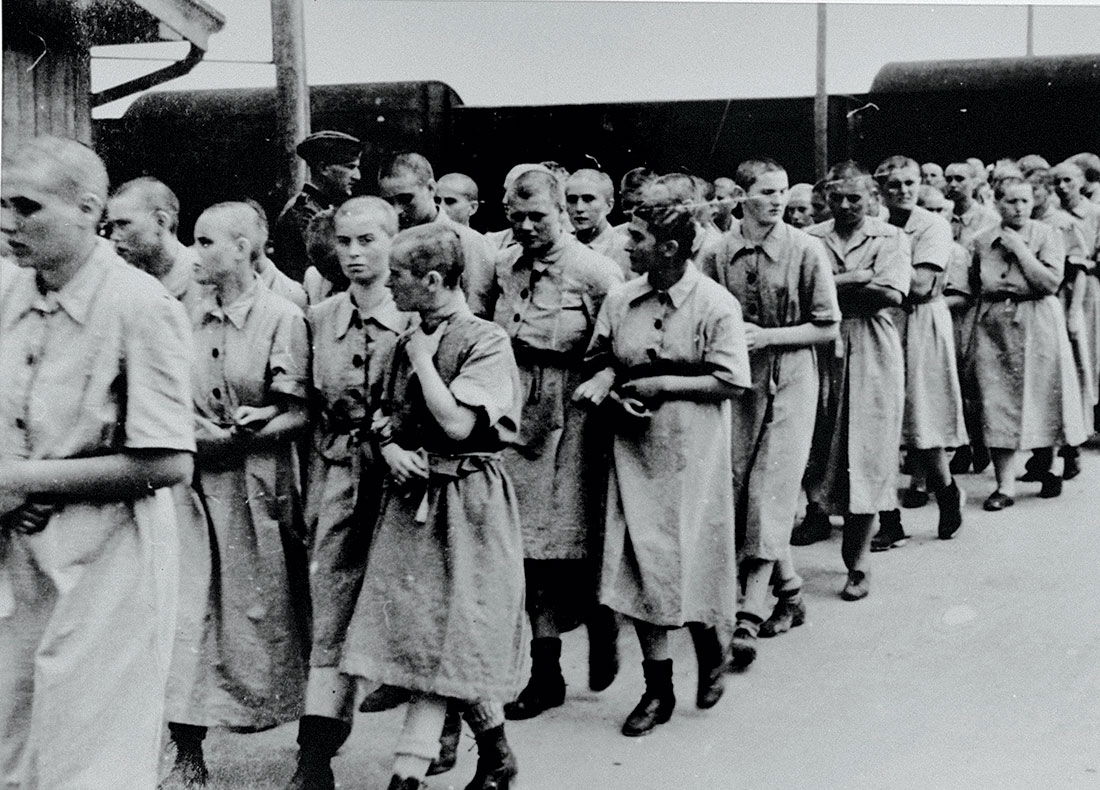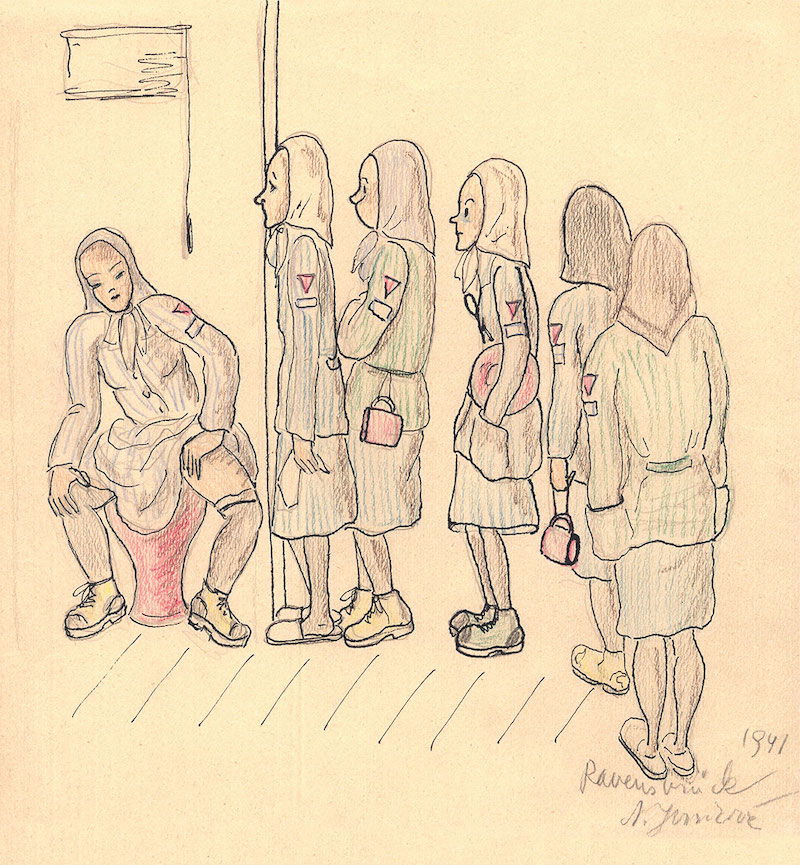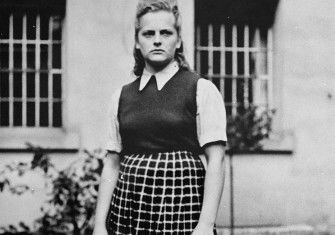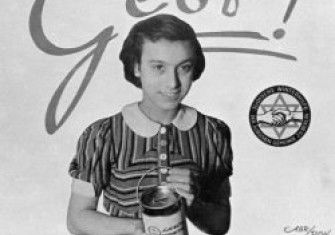Menstruation and the Holocaust
Periods are a fact of life, but little talked about. How did women in the concentration camps cope with the private being made public in the most dire and extreme circumstances?

Menstruation is rarely a topic that comes to mind when we think about the Holocaust and has been largely avoided as an area of historical research. This is regrettable, as periods are a central part of women’s experience. Oral testimonies and memoirs show that women felt ashamed discussing menstruation during their time in the concentration camps, but, at the same time, they kept bringing the subject up, overcoming the stigma that is attached to them.
Typically, menstruation has been seen as a medical problem to be overcome rather than as a natural occurrence and a part of life. Medical historians, for example, have explored the forced experiments in sterilisation that were conducted in Auschwitz. Sabine Hildebrandt examined the research of the pathologist Hermann Stieve, who experimented on female political prisoners awaiting execution in Plötzensee. Stieve looked at the effect stress had on the reproductive system. Similarly, Anna Hájková has written about the Jewish Theresienstadt prisoner and physician František Bass’ research on amenorrhoea, the loss of menstruation, which focused on how it was caused by the shock of incarceration. Interestingly, however, almost all this research discussed ovulation (and its lack) rather than menstruation, even though both are part of the same biological function.
Periods impacted on the lives of female Holocaust victims in a variety of ways: for many, menstruation was linked to the shame of bleeding in public and the discomfort of dealing with it. Periods also saved some women from being sexually assaulted. Equally, amenorrhoea could be a source of anxiety: about fertility, the implications for their lives after the camps and about having children in the future.
A much-cited argument in Holocaust scholarship, made by Hannah Arendt, is that the totalitarian regime of the camps broke human solidarity, making them a very isolating place to be. But, contrary to this view, periods could provide moments of bonding and solidarity among prisoners: many older women gave help to teenagers, who experienced their first period alone after their families had been murdered. When we look for it, many survivors talk with great openness about their periods. Having or not having a period could shape daily experience of the camps.
What is a woman?
After deportation to camps and ghettos, due to malnutrition and shock, a significant number of female Holocaust victims of reproductive age stopped menstruating. Many were afraid that they would be left infertile after their bodies were forced to their limits, making the intrinsic link between periods and fertility apparent and increasingly central to their lives. Gerda Weissman, originally from Bielsko in Poland and 15 years old during her incarceration, later reflected that a key reason she wanted to survive was because she wanted to have children. She described it as ‘an obsession’. Similarly, the French publicist, resistance fighter and Auschwitz survivor Charlotte Delbo mentions a discussion that took place among a room full of women:
It’s upsetting not to go through those unclean period … You begin to feel like an old woman. Timidly, Big Irene asked: ‘And what if they never come back afterwards?’ At her words a ripple of horror swept over us … Catholics crossed over themselves, others recited the Shema; everyone tried to exorcise this curse the German were holding over us: sterility. How could one sleep after that?
These reactions reflected both religious and cultural diversity, showing that regardless of faith, culture or nationality, it was a worry all could relate to. The historian of Holocaust literature S. Lillian Kremer argued that, in addition to the fear of becoming infertile, the prisoners’ uncertainty over whether their fertility would return if they survived made the loss of menstruation a ‘dual psychological assault’ on female identity.
Upon entry into the camp, prisoners were given shapeless clothing and had their heads shaved. They lost weight, including from their hips and breasts, two areas commonly associated with femininity. Oral testimonies and memoirs show that all of these changes compelled them to question their identities. When reflecting on her time in Auschwitz, Erna Rubinstein, a Polish Jew who was 17 when in the camps, asked in her memoir, The Survivor in Us All: Four Young Sisters in the Holocaust (1986): ‘What is a woman without her glory on her head, without hair? A woman who doesn’t menstruate?’

It is only due to the commercialisation of a natural physical occurrence that we now have resources such as pads and tampons that are specifically geared towards easing the ‘inconvenience’ of menstruation. Terms such as ‘sanitary equipment’ show that menstruation is treated as a health and hygiene concern - something to be sanitised. The reality of the camps, however, meant that menstruation was hard to avoid or hide. Its suddenly public nature took many women by surprise and made them feel alienated. An additional obstacle was the lack of rags and the lack of opportunities to wash. Trude Levi, a Jewish-Hungarian nursery teacher, then aged 20, later recalled: ‘We had no water to wash ourselves, we had no underwear. We could go nowhere. Everything was sticking to us, and for me, that was perhaps the most dehumanising thing of everything.’ Many women have talked about how menstruating with no access to supplies made them feel subhuman. It is the specific ‘dirt’ of menstruation more than any other dirt, and the fact that their menstrual blood marked them as female, that made these women feel as though they were the lowest level of humanity.
The humiliation was furthered by the struggle of finding rags. Julia Lentini, a 17-year-old Romani from Biedenkopf in Germany, spent her summer months travelling through the country with her parents and 14 siblings. She was placed on kitchen detail during her time in Auschwitz-Birkenau and later Schlieben. She discusses in her testimony how women had to learn tricks for survival when it came to menstruation in the camps. ‘You took the undergarment slip they gave you, ripped it and made little rags, and guarded those little rags like they were gold … you rinsed them out a little bit, put them under the mattress and dried them, then nobody else could steal the little rags.’ Rags were precious and, being so, they were not immune to theft. Some people compensated by using other materials. Gerda Weissman recalls: ‘It was a hard thing because you had no supplies you know. You had to find little pieces of paper and some things from under the loos.’
Rags could almost be considered to have their own micro-economy. As well as being stolen, they were given away, borrowed and traded. Elizabeth Feldman de Jong’s testimony highlights the value of second-hand rags. Not long after she arrived at Auschwitz, her periods disappeared. Her sister, however, continued to menstruate every month. Experiments involving injections in the womb were common, but if a woman was on her period doctors often avoided operating, finding it too messy. One day, Elizabeth was called to have an operation. There were no clean clothes as opportunities to wash were limited, so Elizabeth put her sister’s underwear on and showed the doctor, telling him that she had her period. He refused to operate. Elizabeth realised she could use her sister’s situation to save herself from experimentation and did so another three times at Auschwitz.
Shame and salvation
Livia Jackson, barely old enough to menstruate, felt repulsion at seeing blood flowing down the legs of another girl during roll call: ‘I would rather die than have blood flowing down my legs.’ Her reaction conveys a common attitude: although the lack of access to supplies to stem their menstrual flow was not their fault, many women still felt ashamed.
Scholar Breanne Fahs argues that women’s bodies are viewed as ‘leaky and troublesome’ and their bodily functions are seen as inconvenient, distasteful and unhygienic. Men, on the other hand, tend to receive praise for their secretions: urine, flatulence and semen can be seen as humorous, even sexy. Yet the very notion that periods are repulsive could save women during the Holocaust from being raped. Doris Bergen’s classic discussion of sexual violence in the Holocaust includes an interesting example of two Polish-Jewish women assaulted by Wehrmacht soldiers:
On 18 February 1940 in Petrikau, two sentries … abducted the Jewess Machmanowic (age eighteen) and the Jewess Santowska (age seventeen) at gunpoint from their parents’ homes. The soldiers took the girls to the Polish cemetery; there they raped one of them. The other was having a period at the time. The men told her to come back in a few days and promised her five zlotys.
Similarly, Lucille Eichengreen, a young German-Jewish prisoner, recalled in her memoir that during her imprisonment in a Neuengamme satellite camp in the winter of 1944-5, she had found a scarf and was thrilled: she planned to use it to cover her shorn head. Worried that she would be punished for owning a prohibited object, Eichengreen hid the scarf between her legs. Later, a German guard took her aside and, while attempting to rape her, groped her between her legs and felt the scarf. The man exclaimed: ‘You dirty useless whore! Phooey! You’re bleeding!’ His error protected Lucille from rape. In discussing these stories, we must discern the irony at hand: it is rape that should be viewed as disgusting and menstruation as natural and acceptable.
Camp families
Some teenagers experienced their first period in the camps alone, separated from their families or orphaned. In such cases, older prisoners provided help and advice. Tania Kauppila, a Ukrainian in Mühldorf concentration camp, was 13 when she started her periods. She did not know what was happening and shed many tears. She was scared that she was going to die and did not know what to do. Older women in the camp taught her and others in the same position about periods. The girls were taught how to handle it and what they needed to do in order to cope with the blood flow. It was a different learning process than they would have had at home: ‘You tried to steal a piece of brown paper, you know, from the bags and do the best you can’, recalled Kauppila. This story reoccurs across numerous oral testimonies. Many orphaned survivors who had just started mentioned the help of older women, who took on both a sisterly and motherly role in helping these young girls, before they experienced potential amenorrhoea; older women usually lost their period within the first two or three months of imprisonment.
Feminist scholars such as Sibyl Milton have pointed out the female ‘camp families’ that formed. It is striking, however, that the sisterhood of menstruation has not been written about. As Lentini highlights, if a girl got her period and did not know who to talk to, an older woman would usually ‘explain it very simply’. Twenty-year-old Hungarian Vera Federman spent time in Auschwitz and the Allendorf. She and a friend were able to get work in the kitchen, a precious job. Eating extra potatoes caused their periods to come back and then both girls stole rags from the female guards. This theft, of course, put them in great danger (not to mention the threat of losing their job), but Federman stressed the solidarity with her friend as they teamed up to help each other. In the often violent world of the camps, older women were willing to help educate unknown young girls, expecting nothing in return.
Gendered social networks of support and help developed in the camps. Arendt wrote that ‘the camps are meant not only to exterminate people and degrade human beings, but also serve the ghastly experiment of eliminating, under scientifically controlled conditions, spontaneity itself as an expression of human behaviour’. The female solidarity brought about by the shared experience of menstruation, however, tells another story.
After the liberation, the majority of those who suffered amenorrhoea during their time in the concentration camps eventually started menstruating again. The return of periods was a joyous occasion for many. London-born Amy Zahl Gottlieb was, at 24, the youngest member of the first Jewish Relief Unit ever posted overseas. While discussing her work with liberated camp members in her interview with the United States Holocaust Memorial Museum, Gottlieb described how women began to lead normal lives and started to menstruate again; they were thrilled to be able to start having children. Menstruation became a symbol of their freedom. One survivor spoke of it as ‘my womanhood returning’.
The study of menstruation, a topic that has until now been perceived as irrelevant, or even disgusting, gives us a far more nuanced view of women’s experience of the Holocaust. We can see how notions of menstruation, rape, sterility and sisterhood changed in the camps. It seems that periods, a long-stigmatised topic, became, sometimes in the space of only months, a legitimate topic for women in camps.
Following the recent turns to cultural history, the history of the senses and the history of the body, we also need to recognise menstruation as valid and as defining victims’ experiences during the Holocaust.
Jo-Ann Owusu is a recent History graduate from the University of Warwick.






